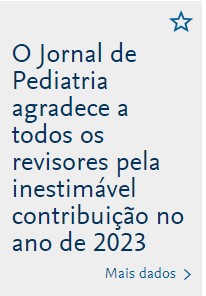to investigate the prevalence and risk factors associated with wheezing in infants in the first year of life.
Methodsthis was a cross-sectional study, in which a validated questionnaire (Estudio Internacional de Sibilancias en Lactantes - International Study of Wheezing in Infants - EISL) was applied to parents of infants aged between 12 and 15 months treated in 26 of 85 primary health care units in the period between 2006 and 2007. The dependent variable, wheezing, was defined using the following standards: occasional (up to two episodes of wheezing) and recurrent (three or more episodes of wheezing). The independent variables were shown using frequency distribution to compare the groups. Measures of association were based on odds ratio (OR) with a confidence interval of 95% (95% CI), using bivariate analysis, followed by multivariate analysis (adjusted OR [aOR]).
Resultsa total of 1,029 (37.7%) infants had wheezing episodes in the first 12 months of life; of these, 16.2% had recurrent wheezing. Risk factors for wheezing were family history of asthma (OR = 2.12; 95% CI: 1.76-2.54) and six or more episodes of colds (OR = 2.38; 95% CI: 1.91-2.97) and pneumonia (OR = 3.02; 95% CI: 2.43-3.76). For recurrent wheezing, risk factors were: familial asthma (aOR = 1.73; 95%: CI 1.22-2.46); early onset wheezing (aOR = 1.83; 95% CI: 1.75-3.75);nocturnal symptoms (aOR = 2.56; 95% CI: 1.75-3.75), and more than six colds (aOR = 2.07; 95%CI 1.43- .00).
Conclusionthe main risk factors associated with wheezing in Fortaleza were respiratory infections and family history of asthma. Knowing the risk factors for this disease should be a priority for public health, in order to develop control and treatment strategies.
verificar a prevalência e fatores de risco associados à sibilância em lactentes no primeiro ano de vida.
Métodosestudo transversal, onde foi aplicado o questionário padronizado e validado (Estudio Internacional de Sibilancias en Lactantes-EISL) aos pais de lactentes com idade entre 12 e 15 meses que procuraram 26 das 85 unidades de atenção básica, no período 2006 a 2007. A variável dependente, sibilância, foi definida utilizando os seguintes padrões: ocasional (até dois episódios de sibilância) e recorrente (três ou mais episódios). As variáveis independen- tes foram apresentadas usando distribuição de frequências, utilizadas para comparar os grupos. As medidas de associações foram baseadas em razão de chances (odds ratio-OR), com intervalo de confiança de 95% (IC95%), com análise bivariada, seguida de análise mul- tivariada (OR ajustada).
Resultadosum total de 1.029 (37,7%) lactentes apresentou sibilância nos primeiros 12 meses de vida e destes, 16,2% tiveram sibilância recorrente. Os principais fatores de risco associados à sibilância foram: história familiar de asma (ORa = 2,12; IC95%: 1,76-2,54); seis ou mais episódios de resfriado (ORa = 2,38; IC95%: 1,91-2,97) e pneumonia (ORa = 3,02; IC95%: 2,43-3,76) e sibilância recorrente foram: asma na família (ORa = 1,73; IC95%: 1,22- 2,46); início precoce de sibilância (ORa = 1,83; IC95%: 1,75-3,75); sintomas noturnos (ORa = 2,56; IC95%: 1,75-3,75); mais de 6 resfriados (ORa = 1,83; IC95%: 1,75-3,75)
Conclusãoos principais fatores de risco associados à sibilância foram as infecções respira- tórias e história de asma na família. Conhecer os fatores de risco dessa enfermidade deve ser uma prioridade para a saúde pública, que poderá desenvolver estratégias de controle e tratamento.
Como citar este artigo: Bessa OA, Leite AJ, Solé D, Mallol J. Prevalence and risk factors associated with wheezing in the first year of life. J Pediatr (Rio J). 2014;90:190-6.









